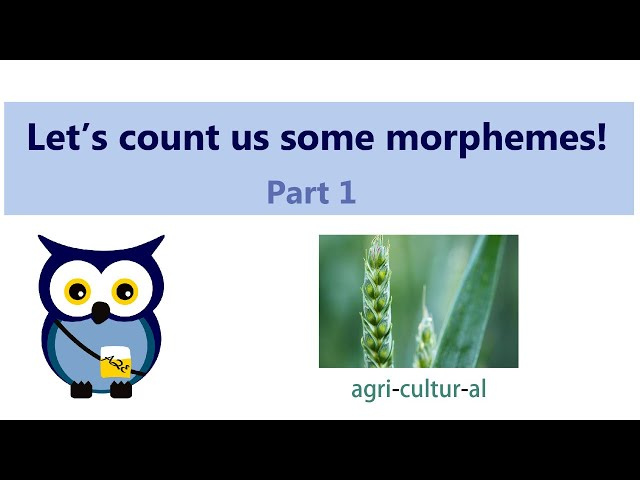Language is an intricate system that allows us to communicate complex ideas and emotions. Within any language, basic units called morphemes are the smallest meaningful elements. Understanding how many morphemes are present in a given sentence or word can provide insights into language complexity and structure. Calculating the number of morphemes might seem daunting if you’re not a linguist, but fortunately, it can be simplified using certain tools and techniques. Here, we’ll explore a variety of approaches to quantify morphemes, ensuring that anyone, regardless of technical expertise, can grasp the process.

Morpheme Counter Tool
There’s a selection of online tools specifically designed to count morphemes in a sentence or word, providing a straightforward approach for those who are new to morphological analysis.
- Access a morpheme counting tool online by searching for “morpheme counter” in your preferred search engine.
- Enter the word or sentence you wish to analyze into the designated text box.
- Click the “Analyze" or "Count” button to let the tool process your input.
- The tool will display the number of morphemes found in the text.
By using an online morpheme counter, the process of morpheme analysis becomes accessible to everyone. It’s quick and user-friendly, but reliance on such tools may not always provide the nuance and understanding that manual analysis offers, which can be essential in educational settings or for thorough linguistic research.
Word Segmenter
Some linguistic software can segment words into their component morphemes, acting as an educational tool to help you visually discern the structure of words.
- Download and install a word segmenter program appropriate for your operating system.
- Launch the application and familiarize yourself with the user interface.
- Type in or paste the words you wish to segment into morphemes.
- The software will break down the words and highlight individual morphemes.
This solution provides an interactive way to see how words are constructed, which can enhance learning. However, software limitations and potential errors in automatic segmentation could lead to inaccuracies.
Linguistic Textbooks and Resources
Many linguistic textbooks and resources contain detailed explanations of morphemes and how to identify them, complete with examples.
- Locate a reputable linguistic textbook or online resource that covers morpheme analysis.
- Read the relevant chapters or sections focusing on morphemic structure and identification.
- Apply the principles learned to the text by manually separating it into morphemes.
- Count the total number of morphemes for your analysis.
Linguistic textbooks are a great way to understand the theory behind morpheme identification, providing a solid foundation for manual analysis. However, the process can be time-consuming and requires a level of study and concentration that might not suit everyone.
Morphological Tree Diagram Generator
To visualize the structure of morphemes within words, a morphological tree diagram generator can be an effective tool.
- Search for an online morphological tree diagram generator.
- Input the word or phrase you wish to analyze.
- Follow the instructions to generate the tree diagram.
- Use the resulting diagram to count and understand the morphemes in your text.
Morphological tree diagrams are helpful in seeing the hierarchical relationship between morphemes, aiding comprehension. This method can be complex for beginners and may require additional learning to interpret the diagrams correctly.
Educational Language Apps
Educational language applications often include features that teach and count morphemes, aiming to make learning fun and interactive.
- Find and download a language learning app that includes morpheme analysis.
- Explore the app’s features and select the morpheme learning module.
- Follow the app’s guidance to input text and analyze morphemes.
- Engage with the app’s activities to reinforce your understanding.
Apps make learning portable and accessible, with interactive elements to keep users engaged. Nevertheless, they might not be as comprehensive as formal educational resources and could oversimplify complex concepts.
Online Language Forums and Communities
Online forums and language learning communities often have sections dedicated to linguistic questions, where you can find help with morpheme counting.
- Join an online forum or community focused on language learning or linguistics.
- Search for existing threads about morpheme counting or create a new one.
- Post your query and wait for responses from the community.
- Use the advice given to improve your morpheme counting skills.
This method facilitates peer learning and provides access to a community of learners and experts. However, the quality of information can vary, and it might take time to receive responses.
Linguistic Tutor or Educator
A linguistic tutor or educator can provide personalized guidance in counting morphemes and offer in-depth explanations.
- Search for a qualified linguistic tutor or contact an educational institution.
- Schedule a lesson or consultation focusing on morphemes.
- Attend the lesson and actively participate in exercises and discussions.
- Use the knowledge gained to confidently count morphemes in any text.
Personalized attention ensures that your individual learning needs are met, although this is typically the most expensive option and requires a significant commitment of time and effort.
Educational Workshops and Seminars
Workshops and seminars often provide focused instruction on linguistic topics, including morpheme analysis.
- Look for upcoming workshops or seminars on linguistics or language analysis.
- Register for the event and attend either in person or online.
- Participate in activities and note the strategies to identify and count morphemes.
- Practice these strategies independently to cement your understanding.
Workshops provide a hands-on learning experience and direct access to experts but may not be available regularly or conveniently located.
Flashcards and Drill Exercises
Using flashcards and morphological drill exercises can be a traditional yet effective way to practice identifying and counting morphemes.
- Create or purchase flashcards that contain words broken down into morphemes.
- Regularly practice with these flashcards, focusing on separating morphemes.
- Use additional drill exercises to further practice your morpheme counting skills.
- Track your progress over time.
These methods promote active recall, which aids in memorization, but can be repetitive and may not appeal to all learning styles.
YouTube Tutorials and Language Channels
YouTube hosts a plethora of language-related channels, many of which cover topics like morphemes in detail.
- Use YouTube’s search function to find tutorials on morphemes.
- Watch videos from reputable educators and linguists.
- Follow along with examples provided to practice counting morphemes.
- Repeat the process with new videos to broaden your understanding.
The visual and auditory nature of video tutorials can make complex concepts more digestible. Nevertheless, the quality and accuracy of such resources can vary, and finding the right educational content may require some sifting.
Each of these methods offers its own benefits, whether it’s the convenience and simplicity of online tools, the depth of understanding provided by textbooks and educators, or the interactive nature of workshops and apps. Conversely, potential downsides may include possible inaccuracies, a lack of depth in the case of some simpler methods, and the time commitment and potential cost associated with more thorough educational approaches.
Language is a fascinating tapestry of sounds, meanings, and structures. Just like a tapestry is made of interwoven threads, language is composed of morphemes woven together to create words and sentences full of meaning. Through the exploration of multiple methods to calculate morphemes, we unlock a greater appreciation and deeper understanding of this structure. Whether you choose to use efficient online tools or engage in intensive study, the path to morphological mastery is rich with learning and discovery.
FAQs:
-
What is a morpheme?
A morpheme is the smallest grammatical unit in a language. It’s a word, or a part of a word, that cannot be broken down further without losing or altering its meaning. -
Why is it important to count morphemes?
Counting morphemes can provide insights into language complexity, linguistic development in children, and language disorders. It also helps learners understand how words are constructed, which can improve language proficiency. -
Can morpheme counting be done manually, or do I need a tool?
Morpheme counting can certainly be done manually, usually with the help of educational resources or through formal training in linguistics. Tools can also help automate the process, making it faster and more accessible for those who may not have linguistic training.









